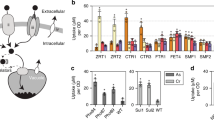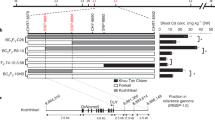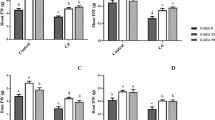Abstract
We have studied the utility of the yeast protein YCF1, which detoxifies cadmium by transporting it into vacuoles, for the remediation of lead and cadmium contamination. We found that the yeast YCF1-deletion mutant DTY167 was hypersensitive to Pb(II) as compared with wild-type yeast. DTY167 cells overexpressing YCF1 were more resistant to Pb(II) and Cd(II) than were wild-type cells, and accumulated more lead and cadmium. Analysis of transgenic Arabidopsis thaliana plants overexpressing YCF1 showed that YCF1 is functionally active and that the plants have enhanced tolerance of Pb(II) and Cd(II) and accumulated greater amounts of these metals. These results suggest that transgenic plants expressing YCF1 may be useful for phytoremediation of lead and cadmium.
This is a preview of subscription content, access via your institution
Access options
Subscribe to this journal
Receive 12 print issues and online access
$209.00 per year
only $17.42 per issue
Buy this article
- Purchase on Springer Link
- Instant access to full article PDF
Prices may be subject to local taxes which are calculated during checkout





Similar content being viewed by others
Accession codes
References
Salt, D.E., Smith, R.D. & Raskin, I. Phytoremediation. Annu. Rev. Plant Physiol. Plant Mol. Biol. 49, 643–668 (1998).
Lanphear, B.P. The paradox of lead poisoning prevention. Science 281, 1617–1618 (1998).
Raskin, I. & Ensley, B.D. Phytoremediation of Toxic Metals (John Wiley & Sons, New York, 2000).
Vido, K.A. Proteome analysis of the cadmium response in Saccharomyces cerevisiae. J. Biol. Chem. 276, 8469–8474 (2001).
Rugh, C.L. et al. Mercuric ion reduction and resistance in transgenic Arabidopsis thaliana plants expressing a modified bacterial merA gene. Proc. Natl. Acad. Sci. USA 93, 3182–3187 (1996).
Rugh, C.L. et al. Development of transgenic yellow poplar for mercury phytoremediation. Nat. Biotechnol. 16, 925–928 (1998).
Zhu, Y.L. et al. Overexpression of glutathione synthetase in Indian mustard enhances cadmium accumulation and tolerance. Plant Physiol. 119, 73–79 (1999).
Zhu, Y.L. et al. Cadmium tolerance and accumulation in Indian mustard is enhanced by overexpressing γ-glutamylcysteine synthetase. Plant Physiol. 121, 1169–1177 (1999).
Salt, D.E. & Wagner, G.J. Cadmium transport across tonoplast of vesicles from oat roots. Evidence for a Cd2+/H+ antiport activity. J. Biol. Chem. 268, 12297–12302 (1993)
Domínguez-Solís, J.R. et al. The cytosolic O-Acetylserine(thiol)lyase gene is regulated by heavy metal and can function in cadmium tolerance. J. Biol. Chem. 276, 9297–9302 (2001).
Li, Z.S. et al. A new pathway for vacuolar cadmium sequestration in Saccharomyces cerevisiae: YCF1-catalyzed transport of bis(glutathionato)cadmium. Proc. Natl. Acad. Sci. USA 94, 42–47 (1997).
Ghosh, M., Shen, J. & Rosen, B.P. Pathways of As(III) detoxification in Saccharomyces cerevisiae. Proc. Natl. Acad. Sci. USA 96, 5001–5006 (1999).
Szczypka, M.S. et al. Yeast metal resistance protein similar to human cystic fibrosis transmembrane conductance regulator (CFTR) and multidrug resistance-associated protein. J. Biol. Chem. 269, 22853–22857 (1994).
Tommasini, R. et al. Transport of oxidized glutathione into barley vacuoles: evidence for the involvement of the glutathione-S-conjugate ATPase. Z. Naturforsch. C Biosci. 48C, 867–871 (1993).
Clemens, S., Palmgren, M. & Krämer, U. A long way ahead: understanding and engineering plant metal accumulation. Trends Plant Sci. 7, 309–315 (2002).
Clemens, S. et al. Tolerance to toxic metals by a gene family of phytochelatin synthases from plants and yeast. EMBO J. 18, 3325–3333 (1999).
Cobbett, C.S. Phytochelatins and their roles in heavy metal detoxification. Curr. Opin. Plant Biol. 3, 211–216 (2000).
Vatamaniuk, O.K. et al. AtPCS1, a phytochelatin synthase from Arabidopsis: isolation and in vitro reconstitution. Proc. Natl. Acad. Sci. USA 96, 7110–7115 (1999).
Rensing, C., Sun, Y., Mitra, B. & Rosen, B.P. Pb(II)-translocating P-type ATPases. J. Biol. Chem. 273, 32614–32617 (1998).
Tommasini, R. et al. The human multidrug resistance-associated protein functionally complements the yeast cadmium resistance factor. Proc. Natl. Acad. Sci. USA 93, 6743–6748 (1996).
Ito, H. et al. Transformation of intact yeast cells treated with alkali cations. J. Bacteriol. 153, 163–168 (1983).
Clough, S.J. & Bent, A.F. Floral dip: a simplified method for Agrobacterium-mediated transformation of Arabidopsis thaliana. Plant J. 16, 735–743 (1988).
Jin, J.B. et al. A New dynamin-like protein, ADL6, is involved in trafficking from the trans-Golgi network to the central vacuole in Arabidopsis. Plant Cell 13, 1511–1526 (2001).
Frangne, N. et al. Flavone glucoside uptake into barley mesophyll and Arabidopsis cell culture vacuoles. Energization occurs by H+-antiport and ATP-binding cassette-type mechanisms. Plant Physiol. 128, 726–733 (2002).
Martinoia, E. et al. An ATP-dependent glutathione S-conjugate 'export' pump in the vacuolar membrane of plants. Nature 364, 247–249 (1993).
Acknowledgements
We thank Dennis Thiele for the YCF1-null yeast line and its isogenic wild type, Yu-Young Kim for technical assistance, and Hyun-Soo Kim, Sandra Preveral and Pann-Ghill Suh for help with microscopy. This work was supported by grants awarded to Y.L. from POSCO and the National Research Laboratory Program of the Korean Ministry of Science and Technology, to E.M. from the Bundesamt für Bildung und Wissenschaft (BBW 00.0413; EU project Metallophytes EU Nr QLK3-CT-2000-00479) and the Körber Stiftung, and to I.H. from the Creative Research Initiative Program of the Ministry of Science and Technology of Korea (M10116000005-02F0000-00310).
Author information
Authors and Affiliations
Corresponding author
Ethics declarations
Competing interests
The authors have applied for a Patent Cooperation Treaty patent, PCT/KR02/12934, titled “Transgenic organism expressing fungal MRP–like ABC transporters”.
Rights and permissions
About this article
Cite this article
Song, WY., Ju Sohn, E., Martinoia, E. et al. Engineering tolerance and accumulation of lead and cadmium in transgenic plants. Nat Biotechnol 21, 914–919 (2003). https://doi.org/10.1038/nbt850
Received:
Accepted:
Published:
Issue Date:
DOI: https://doi.org/10.1038/nbt850
This article is cited by
-
Phytohormones-mediated strategies for mitigation of heavy metals toxicity in plants focused on sustainable production
Plant Cell Reports (2024)
-
A genome-wide co-expression network analysis revealed ZmNRAMP6-mediated regulatory pathway involved in maize tolerance to lead stress
Theoretical and Applied Genetics (2023)
-
Transcriptome profiling of Fagopyrum tataricum leaves in response to lead stress
BMC Plant Biology (2020)



